Shot of the Week 2019/05 – Setting Sun
Someone remarked that so far this year I have been doing a lot of travelling to obtain my shot of the week. That has been purely coincidental since I was visiting those areas for reasons other than photography. On this occasion, though, I have stayed closer to home, the woods behind my house to be precise. Although less than two miles from the centre of town, it is an ancient woodland and a Site of Special Scientific Interest. There is, apparently, evidence of occupation going back to the late Mesolithic era, between 5000 – 3000 BC. It is a remarkable landscape to have in an urban area. On the day, I was fortunate to get some attractive light from the sun as it set.
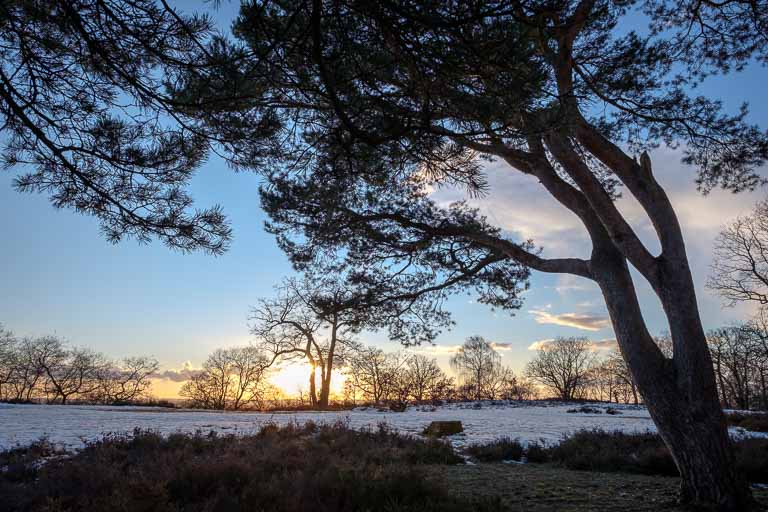
Background
A few years ago, I did a photo-a-day project and hoped that there might be some snow to provide a few picturesque images. It was a case of being careful of what you wish for. The white stuff did indeed come and there were two prolonged spells. In terms of duration, it was the coldest winter of recent years and temperatures remained unseasonably low during the spring and into early summer. I was still wearing gloves in June.
This time around, mindful of what had occurred previously, I was indifferent as to whether there would be any snow. Not that I am superstitious nor that it made any difference; it happened anyway. Albeit not to the extent experienced a few years ago, not so far at least. There is still time with a fair bit of winter to go and March can be a cold month at its beginning. Last year, it was the end of February when the “Beast from the East” swept in.
Given there was snow, I wanted to take advantage although we seemed to have escaped the worst of it in this part of the country. Consequently, it did not settle too thickly. That was great for being able to get around, less good for photography. Nevertheless, I took the opportunity to explore the woods and went there a couple of times.
The best conditions occurred on my first visit. The woods are on a hill and there is a small area of open heathland at the top which catches the afternoon sun. I had an anxious wait as the sky was mostly clear, except for a large cloud covering the sun. Eventually it moved away and there was some glorious light until sunset, when the sky lit up with colour. A prominent feature at the location is a small stand of Scots Pines on which I mainly concentrated.
My chosen image for the week was taken looking out from among the trees towards the setting sun. It has a monochromatic feel and I did try converting it to black and white. That only had the effect of making it less obvious that the bright patch behind the distant tree is the sun. For me, it is a shot which needs some colour, even if there is a limited palette.
Some other shots from the day
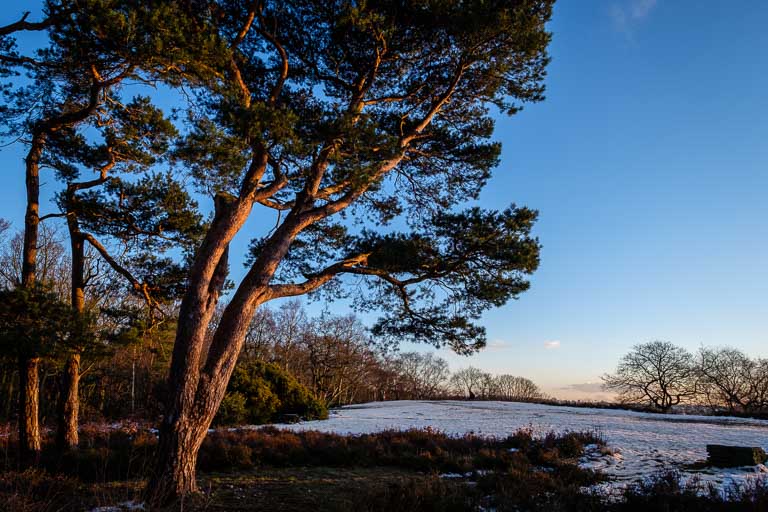
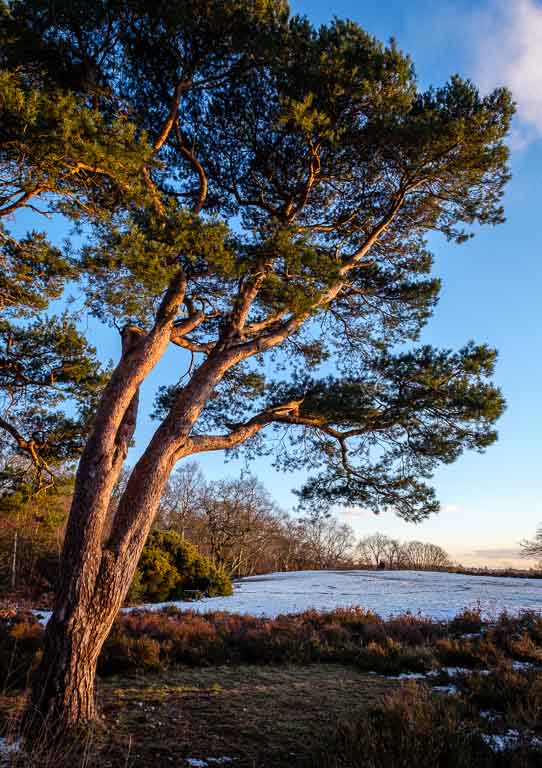
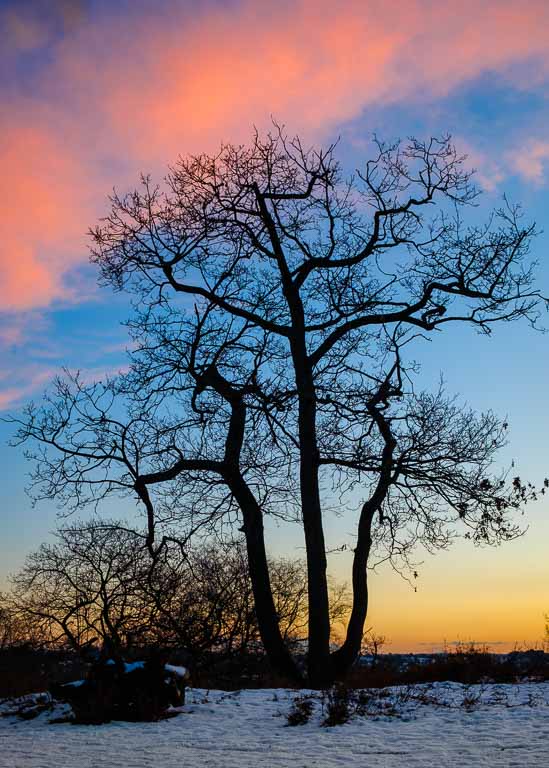
Visualisation Error?
The Scots Pines can, in the right conditions, look good when viewed from the opposite side of the heath. Snow provides one such opportunity, especially if has settled on the trees. Since more snow had fallen overnight and it was only a few minutes’ walk, I went back a couple of days later to see what was happening. The omens were not good as trudged up the hill. The sky was overcast and a thaw was already under way. Any snow which might have been on the trees was long gone and on a grey day there was no detail in the clouds to provide an alternative area of interest.
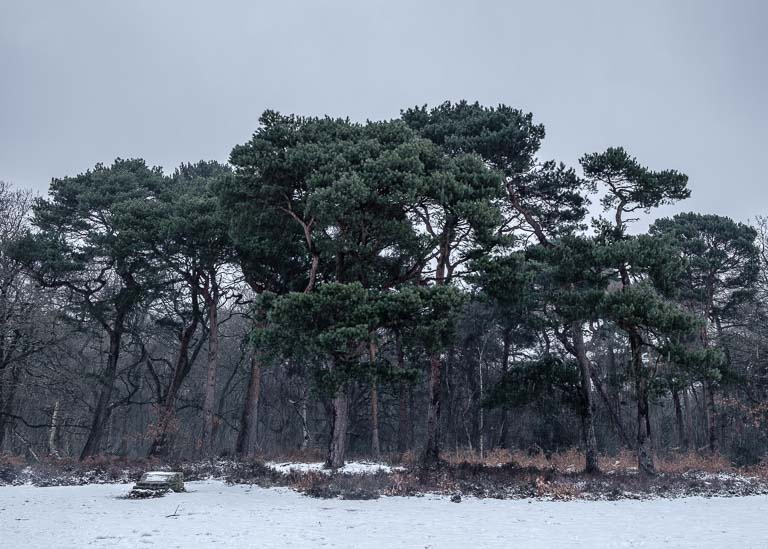
Photography can be like that. Sometimes shots work out, other times they are less successful. On both occasions, I had the luxury of being nearby and observing the conditions before venturing out. This second time, it was more in hope than expectation. Added to which, there was some precipitation in the form of sleet. Despite using a lens hood and keeping the camera pointed down while not shooting, it was a battle to keep the front element clear of water droplets. There will be other days when conditions are more conducive to imagery.
Safety Shot
I like to ensure that I take a photo early in the week so that I know I have something. Flowers are a good standby and this week was no exception. It is another taken with a manual focus macro lens, this time a Leica Elmarit-R 60 macro f/2.8. The design dates back over 50 years and my copy is around 40 years old; it is tack sharp. Leica never recomputed the lens throughout the life of their R series cameras, which ceased production in 2009. There was no need.
Unlike the vintage Vivitar 55 macro lens which I have used previously, the Leica performs well at all focussing distances. Some people opt to use it as their standard lens in preference to the Summicron-R 50 f/2. A minor downside is that the manual focussing ring has a long throw, being optimised for the fine adjustments required for macro work. All it really means is a bit more turning is necessary, which can make focus fractionally slower to achieve.

Natively, the Leica macro lens focusses to a 1:2 reproduction ratio. That did not quite fill the frame for this shot of an anemone, but there is an optional dedicated extender which takes the lens to 1:1. I attached the lens to my Sony A7 II and the aperture was f/16 to maximise depth of field.